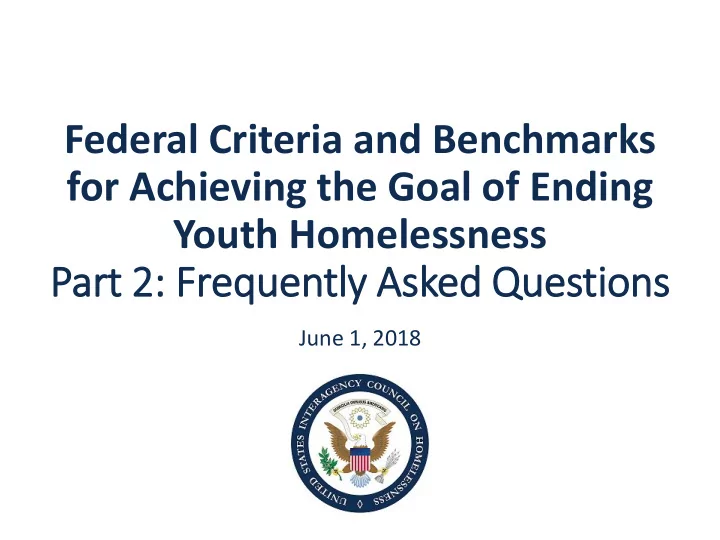

Federal Criteria and Benchmarks for Achieving the Goal of Ending Youth Homelessness Part 2: : Frequently Asked Questions June 1, 2018
Panelists Katy Miller Regional Coordinator Jasmine Hayes Deputy Director Katie Jennings Policy and Program Analyst 2
Webinar Agenda I. Background and Framing II. Purpose of Criteria and Benchmarks III. Commonly Asked Questions IV. Additional Resources 3
Federal Vision: Coordinated Community Response #1 - Build the foundation for a coordinated and comprehensive community response #2 - Build the capacity of local communities to implement the components of a coordinated and comprehensive community response Learn more: Coordinated Community Response to Youth Homelessness 4
Purpose of f Criteria and Benchmarks • Work together • Provide a complete picture and an ongoing assessment of a community’s response to homelessness. • Criteria • Essential elements of the community’s response to homelessness. • Benchmarks • Important indicators of whether and how effectively system is working. https://www.usich.gov/tools-for-action/criteria-and-benchmarks-for-ending-youth-homelessness 5
Benchmarks Benchmark A: There are few youth experiencing homelessness at any given time. Benchmark B: Youth experiencing homelessness are swiftly connected to safe and stable housing opportunities and to permanent housing options. https://www.usich.gov/resources/uploads/asset_library/Youth-Criteria-and- Benchmarks-revised-Feb-2018.pdf 6
Frequently Asked Questions 7
Q1. Can you explain the intent behind Benchmark A, Indicator 5 ? 8
Benchmark A: : In Indicator 5 The number of unaccompanied youth currently experiencing sheltered homelessness (including emergency shelter, basic center program, and time- limited or temporary housing) demonstrates the community’s capacity to address emerging needs through exits to permanent or non-time-limited safe and stable housing destinations, including reunification with family. 9
Indicator 5 Cont’d… Specifically, the number of unaccompanied youth experiencing sheltered homelessness is: • Less than or equal to twice the monthly average number of unaccompanied youth newly identified as experiencing sheltered homelessness, AND • Less than or equal to twice the monthly average number of unaccompanied youth exiting sheltered homelessness to permanent or non- time-limited safe and stable housing destinations. 10
Q2. How is Benchmark A, Indicator 5 different from Benchmark A, Indicator 6 ? 11
Benchmark A: : In Indicator 6 The community’s census of unaccompanied youth experiencing homelessness is not increasing over time. 12
Q3. Which youth are included in the calculation of Benchmark B ? 13
Benchmark B: Youth experiencing homelessness are swiftly connected to safe and stable housing opportunities and to permanent housing options. 14
Benchmark B: : In Indicator 1 Unaccompanied youth identified as experiencing unsheltered or sheltered homelessness (including emergency shelter or basic center programs) exit to permanent or non-time-limited safe and stable housing within a community-wide average of 30 days, and no longer than 90 days from the point of identification. 15
Q4. Do you have any guidance on helping communities integrate different data sources given the privacy rules and barriers to data-sharing a lot of us are struggling with? 16
Q5. What are federal partners doing to make sure systems outside of the homelessness services system are also being held accountable for community achievement of the goal? 17
Q6. Have you defined prevention and diversion for the criteria and benchmarks? 18
Q7. Are we supposed to be able to answer ‘yes’ to all of the questions in the Questions to Assess Guidance? 19
Q8. My community has all of the essential elements described by the criteria in place, and is meeting all of the indicators - except that we still have a few unsheltered youth on our by-name list. Have we achieved the goal? 20
Q9. Should parenting youth be tracked under the youth benchmarks, the family benchmarks, or both? 21
Q10. Can you clarify what “connections to appropriate services on an ongoing basis” means? 22
Q11. And “connections to appropriate services” includes youth who are identified by schools with a Primary Nighttime Residence of doubled-up? 23
Q12. We’ve recently ramped up outreach efforts, and as a result, our inflow numbers are higher. Will we be penalized for this? 24
Q13. In Benchmark B, what is meant by “another residential placement?” 25
Q14. How is “point of identification” being defined? 26
Q15. The majority (or all) of the housing resources for youth in my community are time-limited programs such as transitional housing. How can we build a greater array of non-time-limited safe and stable housing options for young people? 27
Q16. My community believes we are close to achieving the goal. Is there a process to submit our progress for review and confirmation by federal partners? 28
Additional Resources • www.usich.gov/goals/youth • Framework to End Youth Homelessness • Preventing and Ending Youth Homelessness: A Coordinated Community Response • Criteria and Benchmarks for Achieving the Goal of Ending Youth Homelessness and Questions to Assess Your Community's Progress • Using a Housing First Philosophy When Serving Youth • Ending Youth Homelessness Guidebook Series: System Planning • Ending Youth Homelessness Guidebook Series: Promising Program Models • Coordinated Entry Policy Brief • Youth Specific FAQs for Coordinated Entry 29
Thank you! Katy Miller, Regional Coordinator katy.miller@usich.gov Jasmine Hayes, Deputy Director jasmine.hayes@usich.gov Katie Jennings, Policy and Program Analyst katelyn.jennings@usich.gov Find your USICH Regional Coordinator 30
www.usich.gov
Recommend
More recommend